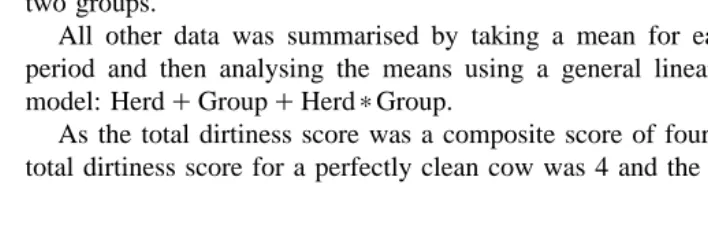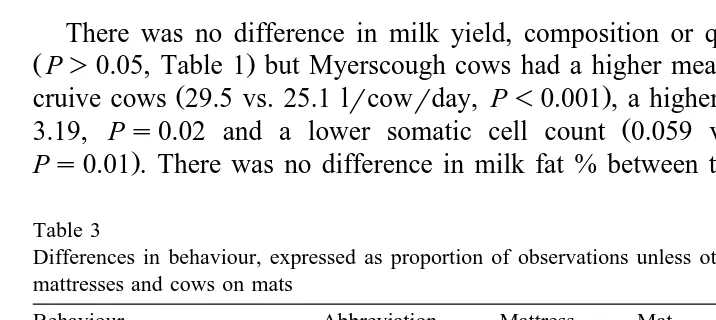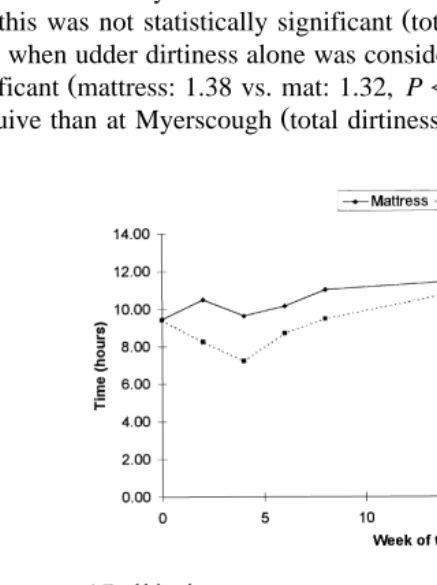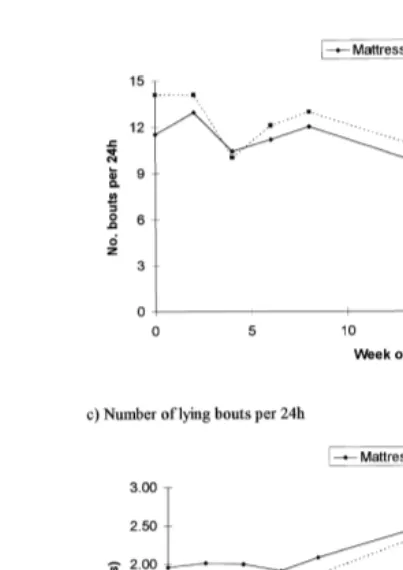www.elsevier.comrlocaterapplanim
An evaluation of mattresses and mats in two dairy
units
S.J. Chaplin
a,), G. Tierney
b, C. Stockwell
c, D.N. Logue
a,
M. Kelly
ba
Dairy Health Unit, Scottish Agricultural College Veterinary Science DiÕision, AuchincruiÕe, Ayr KA6 5AE,
Scotland, UK
b
Scottish Agricultural College Building Design Department, AuchincruiÕe, Ayr KA6 5HW, Scotland, UK
c
Myerscough Agricultural College, Bilsborrow, Preston, Lancashire, PR3 0RY, UK
Accepted 6 October 1999
Abstract
In order to investigate the relative merits of mats and mattresses in terms of cow comfort,
Ž .
production and performance, 29 cows were housed on ethylethene vinyl acetate EVA mats and 29 on mattresses of loose rubber crumb with a polypropylene cover, at each of two similar dairy
Ž .
units SAC Auchincruive and Myerscough . Both mats and mattresses were newly installed at the start of the trial. The cows were housed in the autumn after calving. Milk yield was recorded daily. Cows were weighed and scored for body condition, locomotion, dirtiness and hock and knee injury at fortnightly intervals. Feed offered was recorded daily and refusals were weighed weekly. Monthly milk records of milk yield, milk composition and somatic cell count data were available for both herds. In addition, 24 h behavioural observations of 15 core cows in each group were made at weeks 0, 2, 4, 6, 8, 16, and 32 post-housing. There was no difference between cows on mats and mattresses in milk yield, composition or quality; in feed intake; in weight loss or body condition score; in severe hock or knee injury, or in the incidence of lameness. Cows on
Ž
mattresses tended to have slightly higher total dirtiness scores than those on mats 7.06 vs. 6.95,
. Ž .
Ps0.074 and had dirtier udders mattress, 7.50 vs. mat, 6.52, P-0.05 . However, over the whole housing period, cows on mattresses spent longer feeding, ruminating and lying and a greater proportion of their lying time was spent ruminating. They spent less time standing doing
Ž .
nothing idling than cows on mats and less time idling in cubicles. Cows on mattresses appeared to adapt to housing more quickly than those on mats. Overall, neither mat nor mattress gave
)Corresponding author. Tel.:q44-1292-520318; fax:q44-1292-521047.
Ž .
E-mail address: [email protected] S.J. Chaplin .
0168-1591r00r$ - see front matterq2000 Elsevier Science B.V. All rights reserved.
Ž .
advantages in terms of production or performance, cows were slightly cleaner on mats but behavioural indices suggest that cow comfort was greater on mattresses.q2000 Elsevier Science
B.V. All rights reserved.
Keywords: Cattle-welfare; Mattress; Lying behaviour
1. Introduction
Lying surfaces for dairy cows must provide thermal comfort and softness, yet be durable and have sufficient friction to allow rising and lying down without slipping. Finally, they should help in keeping cows clean and healthy whilst minimising daily
Ž .
labour requirements Natzke et al., 1982; Nilsson, 1992; Rodenburg et al., 1994 .
Ž . Ž .
Cermak 1990 and Bolling 1994 both found that as the softness of bedding in cubicles
´
¨
increased from bare concrete, to concrete with rubber mats, to straw bedding, lying
Ž .
times increased. Bolling 1994 also showed that lying times on mattresses are equiva-
¨
lent to those on straw bedding. The results suggested that cow comfort can be assessed by lying behaviour.
Where straw is not an economic option for cow bedding, mats and mattresses are often used to cushion a concrete cubicle base. There are many products available to dairy farmers, all claiming such advantages as: improved cow comfort, longer lying times, reduced stress, increased milk yield, better cow cleanliness and cubicle hygiene and less cow injury. Previous studies comparing mats and mattresses have either focused
Ž .
on cow cleanliness Rodenburg et al., 1994; Visser, 1994 or short-term cow preferences
ŽNatzke et al., 1982 . None have evaluated the longer-term performance of these.
products. This is particularly important for mattresses that flatten with time. Rubber
Ž .
mats offer little cushion and require additional bedding for cow comfort Britten, 1994 . If mattresses flatten with time and are allowed to become too hard they offer little
Ž .
benefit over mats and hock lesions may result Britten, 1994 .
This study was designed to compare and contrast the relative merits of mats and mattresses in terms of cow comfort, production and performance over a whole housing period.
2. Materials and methods
Ž .
At each of two similar dairy units SAC Auchincruive and Myerscough , 29 cows
Ž . Ž
were housed on either mats Cow Comfort ‘‘Maxi-bed’’ or mattresses Pasture B.V.
. Ž .
‘‘Pasture Mat’’ . The mats were made of ethylene vinyl acetate EVA whereas the mattresses were made of small rubber crumb enclosed in a bag with 12 cells to prevent movement and compaction, and covered with polypropylene. Both products were market leaders of their type and all mats and mattresses were newly installed at the start of the trial. All cows calving in the 30 days prior to housing at the end of September were
Ž .
added to each group to maintain the stocking density until a further 28 cows had calved at each site. At eight weeks post-housing, the summer-calved ‘‘fillers’’ were replaced by these early lactation, autumn calving ‘‘fillers’’. The groups then remained constant for the remainder of the housing period, which was approximately 28 weeks in total. At both sites, the groups were matched for lactation number, days post calving, previous lameness history and previous milk yield. The groups were also balanced for breed at Auchincruive, where a mixture of Holstein–Friesians and Ayrshires were milked.
At Auchincruive all cows were housed abruptly from grass but at Myerscough the cows were allowed a transition period of about one week before housing. Cubicles at
Ž
Auchincruive were all of the Dutch Comfort design length, 2.10–2.20 m=width,
. Ž
1.15–1.18 m . At Myerscough, Mushroom cubicles were installed length, 2.30 m=
.
width, 1.20–1.21 m . Both of these cubicle types are designed to allow space-sharing and provide forward lunging space for rising. Floors were solid concrete at both sites and automatic scrapers were used.
Ž .
Cows at both sites were fed 40 kgrcow of first cut silage in total mixed ration TMR
Ž .
either once or twice daily ad libitum. The dry matter intake DMI of the TMR at
Ž .
Auchincruive was approximately 271 grkg with a 16.8% crude protein CP and at Myerscough, DMI was 298 grkg DMI and CP was 16.7%. Concentrates were fed in
Ž
parlour according to a stepped flat rate at Auchincruive 3 kgrcow up to 100 days
. Ž
post-calving and 0.5 kgrcow thereafter and according to yield at Myerscough 0.1–0.3
.
kgrl .
Milk yield was recorded daily and each herd was milk recorded so monthly milk composition and somatic cell count data was also available for analysis. Weekly feed intake per group was determined from daily records of feed offered and weekly weighing of feed refusals. Every two weeks all cows were weighed and scored for body condition, locomotion, dirtiness and hock and knee injury. Scoring was always carried
Ž .
out by the same person at each site SC at Auchincruive and CS at Myerscough . Locomotion was scored on a five-point scale with half points, as described by Manson
Ž . Ž .
and Leaver 1988 . For dirtiness, four areas of the cow body, legs, rear and udder were
Ž . Ž . Ž .
scored: 1 perfectly clean, 2 quite dirty, or 3 very dirty, with half points, based on
Ž .
the scoring system described by Bergsten and Pettersson 1992 . The sum of the four scores given was the total dirtiness score. Each hock and knee was scored for lesions,
Ž . Ž . Ž .
based on the scores described by Gustafson 1993 : 0 no lesions observed, 1 bare,
Ž . Ž . Ž .
pale areas, 2 bare, red areas, 3 occurrence of serum andror sore scabs, 4 open,
Ž . Ž
infected wounds, 5 swelling andror adventitious bursae fluid filled sac on knee or
.
hock .
The behaviour of the core cows was observed by scan sampling every 15 min for 24 h at weeks 0, 2, 4, 6, 8, 16 and 24, with the first observation being made on the day of
Ž .
housing. A record was made of each cow’s posture standing or lying , location
Žfeed–face, passageway or cubicle and activity feeding, drinking, ruminating, doing. Ž .
nothing or other . Lying behaviour was recorded continuously by noting the exact times of lying down and rising to give true frequencies and durations of lying bouts. The
Ž . Ž .
behaviours of interest taken from these records were: feeding F , lying L , ruminating
Ž Ž . . Ž .
spent in cubicles SO CrSO , maximum lying bout length MaxL , number of lying
Ž .
bouts in 24 h Nbouts .
3. Statistical analysis
Behavioural data was expressed as proportion of observations made, to allow for any
Ž .
differences in the time that cows were away from the cubicles being milked. SO, SO C
Ž .
and SO CrSO were not normally distributed and so were logarithmically transformed before analysis. The data was then analysed by spit-plot ANOVA, with herd as blocks, cow as the whole plot and time as the sub-plot using the treatment model: GroupqTime qGroup)Time. Group was therefore the main plot treatment, and week the sub-plot.
Ž
The number of cows having adventitious bursae on the hock or knee the occurrence
.
at least once of an adventitious bursa or swelling ; having serious lesions on the hock or
Ž . Ž
knee score 3 or 4 at least once ; and, having no severe recorded lesions no hock or
.
knee injury score of greater than 2 were analysed by chi-square. Lameness prevalence was calculated as the number of lame cow weeks divided by the number of cow weeks observed, where lameness was defined as a locomotion score of G3, and chi-square was used to determine significance.
Ž .
Weight loss was calculated as initial weight the first weight recorded after housing minus minimum weight. Weight loss data was heavily skewed, even after log transfor-mation, so a Mann–Whitney test was used on the original data for comparison of the two groups.
All other data was summarised by taking a mean for each cow over the housing period and then analysing the means using a general linear model ANOVA and the model: HerdqGroupqHerd)Group.
As the total dirtiness score was a composite score of four areas, the lowest possible total dirtiness score for a perfectly clean cow was 4 and the highest possible score was
Table 1
Milk yield, composition and quality for cows on mats or mattresses at Auchincruive and Myerscough
Mattress Mat
Au Mc Au Mc
Ž .
Average daily milk yield lrcow 25.3 28.7 24.8 30.4
Protein % 3.19 3.33 3.20 3.22
Butterfat % 4.13 4.22 4.14 4.03
6
Ž .
SCC =10 cellsrml 0.095 0.052 0.073 0.067
Ž .
Average daily milk yield lrcow 27.0 27.6
Protein % 3.26 3.21
Butterfat % 4.17 4.08
Ž .
Weight of fat and protein grcow 200.1 201.3
6
Ž .
Table 2
Lameness and hock and knee injury scores for cows on mats and mattressesa, both herds pooled
Mattress ns89 Mat ns89 p
Hocks
Ž .
Maximum score of 5 no. cows 12 14 0.671
Ž .
Maximum score of 3 or 4 no. cows 29 34 0.433
Ž .
Maximum score of 2 no. cows 48 41 0.294
Knees
Ž .
Maximum score of 5 no. cows 25 19 0.297
Ž .
Maximum score of 3 or 4 no. cows 7 5 0.550
Ž .
Maximum score of 2 no. cows 57 65 0.197
b
Prevalence of lameness 0.060 0.082 0.069
a
All cows in each group, including summer-calved ‘‘fillers’’.
b
No. of lame cow weeks divided by the no. of cow weeks observed.
12. Average total dirtiness and average udder dirtiness scores were log transformed by
Ž .
the formula: log10 scoreq1 , before analysis.
Ž
All statistical tests were carried out using Genstat Version 5, Release 4.1 q Lawes .
Agricultural Trust, IACR, Rothamsted .
4. Results
There was no difference in milk yield, composition or quality between the groups
ŽP)0.05, Table 1 but Myerscough cows had a higher mean daily yield than Auchin-.
Ž . Ž
Differences in behaviour, expressed as proportion of observations unless otherwise stated, between cows on mattresses and cows on mats
Behaviour Abbreviation Mattress Mat SED P
Feeding F 0.25 0.23 0.011 0.057
Ruminating R 0.43 0.39 0.011 0.002
Lying L 0.50 0.44 0.018 0.004
Lying–ruminating LR 0.29 0.23 0.014 -0.001
Lying–ruminating LRrL 0.58 0.50 0.016 -0.001
Žproportion of total lying.
Maximum bout MaxL 2.18 1.89 0.101 0.005
Ž .
length h
Number of lying Nbouts 11 13 0.805 0.017
Ž .
bouts boutsr24 h
a a a
Idling SO 0.10 0.13 0.007 -0.001
a a a
Ž .
Idling in cubicles SO C 0.05 0.07 0.007 0.004
a a a
Ž .
Idling in cubicles SO CrSO 2.13 2.58 0.102 0.166
Žproportion of idling.
a
Cows on mattresses had the higher feed intake in both herds. At Auchincruive the daily DMI of TMR of the mattress group was 12.95 kgrcow compared with 12.70 kgrcow for the mat group, a difference of 0.25 kg DMIrcowrday. At Myerscough, the daily DMI was 17.01 kgrcow for the mattress group and 16.55 kgrcow for the mat group, a difference of 0.47 kgrcow. Average feed intake was higher at Myerscough
Ž .
than Auchincruive 28.15 vs. 23.67 kg freshweightrcowrday . It was impossible to do statistical analysis on these figures as only group averages were available.
There was no difference in weight, body condition score or weight loss between cows
Ž .
on mattresses and cows on mats P)0.05 . Myerscough cows were heavier than those
Ž .
at Auchincruive mean weight: 581 vs. 521 kg, P-0.001 and had slightly better body
Ž .
condition scores 2.6 vs. 2.3, P-0.001 .
There was a tendency for cows on mattresses to be slightly dirtier than those on mats
Ž .
although this was not statistically significant total dirtiness: 7.06 vs. 6.95, Ps0.074 . However, when udder dirtiness alone was considered, the difference between the groups
Ž .
was significant mattress: 1.38 vs. mat: 1.32, P-0.05 . Dirtiness scores were higher at
Ž .
Auchincruive than at Myerscough total dirtiness: 7.50 vs. 6.52, P-0.001 .
Ž .
Fig. 1 continued .
There was no difference between the groups in the number of cows which only ever
Ž
showed hair loss or reddened skin on their hocks and knees scoreF2 for hock and knee
.
injury , in the incidence of swellings andror adventitious bursae on hocks or knees
Žscore 5 for hock or knee injury , or in the number of cows showing evidence of lesions. Žsore scabs, score 3, or open lesions, score 4 . However, a high proportion of cows in.
Ž .
both groups mattress: 46%, mat: 49% had a maximum hock lesion score of greater
Ž .
than 3 Table 2 .
Ž
The incidence of lameness a locomotion score of G3 at least once during the
. Ž .
housing period was the same for both groups Table 2 .
Ž .
All of the behaviours investigated varied significantly with time P-0.001 . Total lying times increased after housing for the cows on mats in the later part of the housing period whereas cows on mattresses reached a plateau and this group)time interaction
Ž .
was significant P-0.001 . MaxL was greater for cows on mattresses by about 15–20
Ž .
min and these cows also had more lying bouts per 24 h Table 3 . Fig. 1 shows how lying behaviour changed over the course of the housing period.
spent ruminating. Cows in the mat area idled for longer and spent longer idling in cubicles, although when idling in cubicles was expressed as a proportion of total idling, there was no difference between the groups. Differences between the groups are shown in Table 3. The group)time interaction was significant for all of these behaviours
ŽP-0.05 ..
5. Discussion
The provision of mattresses did not give any advantages in terms of production or performance: there were no differences between the groups in milk yield, weight, body condition score or weight loss in early lactation. The differences in milk yield between the herds show that Myerscough was a higher producing herd and so the herd differences in milk quality and composition and in feed intake are not surprising. The average liveweight was lower at Auchincruive, probably due to the smaller Ayrshire cows which make up a proportion of that herd.
Udder cleanliness is important in reducing the risk of mastitis and lessening the need to wash cows’ udders in the parlour. Indeed cow cleanliness is required by law: the
Ž . Ž .
Dairy Products Hygiene Scotland Regulations 1995 state that before milking, the teats, udders, flanks, hindquarters and adjacent parts of the abdomen should be clean. In
Ž .
a survey of 18 herds, Rodenburg et al. 1994 found that cows on mattresses were cleaner than cows on mats although their results were confounded by differences in stall management practices.
The difference in price between the two products makes mattresses a considerable investment and it is possible that many of the improvements that farmers report after fitting mattresses may be due to concurrent improvements in management. In this study, cows on mats were slightly cleaner than those on mattresses, and the farm staff believed that this was because mats held the bedding better and were drier. However, although the difference in udder dirtiness was significant, it was not large. A small study on faecal contamination run in conjunction with the main trial showed that there was no
Ž
difference in the coliform count of sawdust collected from mats and mattresses Kelly et
.
al., 1999 .
Despite reports that mattresses reduce the extent of hock injury in cubicle-housed
Ž .
dairy cows Rodenburg et al., 1994 , there were no differences in hock and knee injury found in this trial although the proportion of cows with hock lesions scoring 3 or greater was very high in both groups.
Due to the distance between the two sites, it was impossible for one observer to score the cows in both herds and so, whilst real differences in dirtiness, locomotion and body condition may well exist between the herds no comparisons can be made on the strength of this data. However, within each herd, cows were consistently scored by the same
Ž .
observer SC at Auchincruive and CS at Myerscough so comparisons between the groups are valid.
is eased by the provision of mattresses, by the end of the housing period the cows on mats had managed to adapt too. The early housing period coincided with early lactation for the cows in this trial. Cows in early lactation are known to have more unsettled lying behaviour compared with cows in later lactation, that is they have a shorter total lying
Ž
time, higher frequency of lying and lower maximum bout length Chaplin and
Munks-.
gaard, 1999 . Whether the effect is due to housing or calving, or a combination of the two, the results reported here still reflect the consequences of management for a considerable proportion of cows in the UK which are winter-housed autumn-calvers.
Ž
A greater proportion of the time cows spend lying occurs at night Singh et al., 1993,
. Ž .
1994 . At night, lying is usually divided into two bouts Ruckebusch and Bell, 1970 ,
Ž .
bout lengths are longer than during the day Hedlund and Rolls, 1977 and the time
Ž .
between the first intention movement and lying down is shorter Muller et al., 1989 . At
¨
Auchincruive, where cows were fed morning and evening, it seemed that after the evening feeding, cows on mattresses would enter cubicles and quickly lie down whereas cows on mats would stand in the cubicles for some time before lying down. The difference in idling times between the groups was largely due to increased idling in cubicles, supporting this observation.
6. Conclusion
Installing mattresses offered no advantage in terms of production, performance or health to offset the higher cost. However, although cows on mattresses were slightly dirtier than those on mat, they had more restful behaviour, suggesting that mattresses do improve cow comfort.
Acknowledgements
This trial was financed by the Milk Development Council. The authors are also grateful to Cow Comfort UK and Fullwoodhead Dairy Supplies for supplying the cubicle beds. SC was supported by an A.D. and P.A. Allen Award from the Animal Health Trust. SAC receives funding from SERAD.
References
Bergsten, C., Pettersson, B., 1992. The cleanliness of cows tied in stalls and the health of their hooves as influenced by the use of electric trainers. Preventative Veterinary Medicine 13, 229–238.
Bolling, D., 1994. Cubicle design and lameness. Holstein–Friesian Journal 76, 219.¨
Britten, A.M., 1994. Dairy free stall bedding systems and udder health. Dairy Systems for the 21st Century. In: Proceedings of the 3rd International Dairy Housing Conference, 2–5 Feb., Orlando, FL. pp. 165–172. Cermak, J., 1990. Some housing and management considerations relevant to dairy cow welfare and´
cows in tie–stalls. In: Proceedings of the 33rd International Congress of the International Society for Applied Ethology. Lillehammer, Norway, In press.
Gustafson, G.M., 1993. Effects of daily exercise on the health of tied dairy cows. Preventative Veterinary Medicine 17, 209–223.
Hedlund, L., Rolls, J., 1977. Behaviour of lactating dairy cows during total confinement. Journal of Dairy Science 60, 1807–1812.
Kelly, M., Tierney, G., Chaplin, S.J., Stockwell, C., 1999. Evaluating cow mattresses and mats in dairy units. Report to the Milk Development Council on contract number 96rR6r01.
Manson, F.J., Leaver, J.D., 1988. The influence of concentrate amount on locomotion and clinical lameness in dairy cattle. Animal Production 47, 185–190.
Muller, C., Ladewig, J., Thielscher, H.H., Smidt, D., 1989. Behaviour and heart rate of heifers housed in tether¨ stanchions without straw. Physiology and Behaviour 46, 751–754.
Natzke, R.P., Bray, D.R., Everett, R.W., 1982. Cow preference for free stall surface material. Journal of Dairy Science 65, 146–153.
Ž .
Nilsson, C., 1992. Walking and lying surfaces in livestock houses. In: Phillips, C., Piggins, D. Eds. , Ch. 6 in Farm Animals and the Environment CAB International, Oxfordshire, pp. 93–110.
Rodenburg, J., House, H.K., Anderson, N.G., 1994. Free stall base and bedding materials: effect on cow comfort. Proceedings of the 3rd International Dairy Housing Conference, 2–5 Feb. Orlando, FL. Dairy Systems for the 21st Century, 159–164.
´
Ruckebusch, Y., Bell, F.-R., 1970. Etude polygraphique et comportementale des etats de vieille et de sommeil´
Ž .
chez la vache Bos taurus . Annales de Recherches Veterinaires 1, 41–62.´ ´
Singh, S.S., Ward, W.R., Lautenbach, K., Murray, R.D., 1993. Behaviour of lame and normal dairy cows in cubicles and in a straw yard. Veterinary Record 133, 204–208.
Singh, S.S., Ward, W.R., Hughes, J.W., Lautenbach, K., Murray, R.D., 1994. The behaviour of dairy cows in a straw-yard in relation to lameness. Veterinary Record 135, 251–253.



